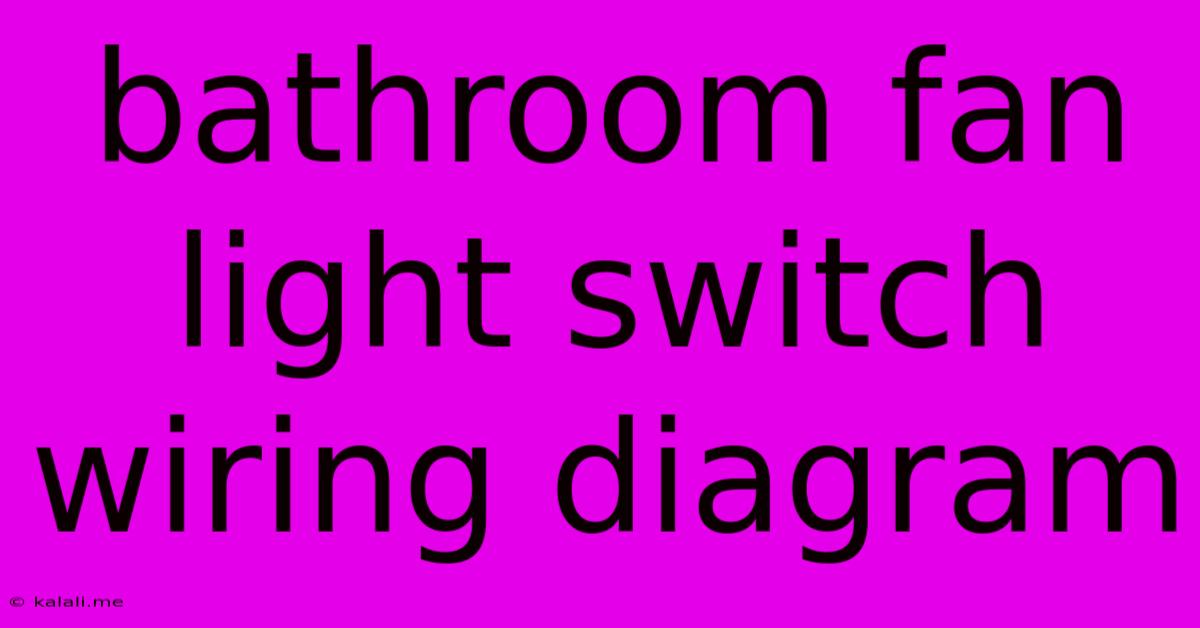Bathroom Fan Light Switch Wiring Diagram
Kalali
May 21, 2025 · 3 min read

Table of Contents
Bathroom Fan Light Switch Wiring Diagram: A Comprehensive Guide
Are you tackling a bathroom remodel and need to understand the wiring for your fan and light? This guide provides a clear explanation of common bathroom fan light switch wiring diagrams, helping you navigate the process safely and effectively. Understanding these diagrams is crucial for proper installation and avoiding electrical hazards. We'll cover different switch configurations and troubleshooting tips.
Understanding the Components
Before diving into the diagrams, let's identify the key components:
- Fan: The exhaust fan removes moisture and odors from the bathroom.
- Light: Provides illumination in the bathroom.
- Switch: Controls both the fan and the light independently or together, depending on the wiring configuration.
- Wiring: Consists of hot (live), neutral, and ground wires. Understanding the color codes is vital (though they can vary slightly). Commonly, black is hot, white is neutral, and green or bare copper is ground.
Common Wiring Configurations
There are two primary wiring setups for a bathroom fan and light controlled by a single switch:
1. Single-Pole Switch with Separate Circuits:
This is the most straightforward setup. The fan and light each have their own separate circuit, controlled by their respective wires leading to the switch.
- Diagram: You'll see two separate sets of wires connecting to the switch – one for the fan (usually black and white) and one for the light (usually black and white). A ground wire will also be connected.
- Functionality: Flipping the switch operates the fan and light independently. Turning the switch on doesn't automatically turn the other on.
- Wiring Notes: Ensure that each circuit is properly grounded for safety. This configuration simplifies troubleshooting. If one malfunctions, it is generally easier to locate the problem source.
2. Single-Pole Switch with Shared Neutral:
In this setup, the fan and light share a neutral wire, which simplifies wiring but makes troubleshooting slightly more complex.
- Diagram: The fan and light will share the same neutral wire, but will have separate hot wires connected to the switch. A ground wire will connect to the switch as well.
- Functionality: The switch operates both the fan and light. Often, one action turns on both. This configuration is common and more space-saving.
- Wiring Notes: While space-saving, tracing problems could be slightly more difficult than separate circuits. Double-check all connections to ensure a secure and safe setup.
Three-Way Switch Configuration (Less Common in Bathrooms)
While less frequent in bathrooms, you might encounter a three-way switch setup, allowing you to control the fan and light from two different locations.
- Diagram: This involves two three-way switches and a more complex wiring arrangement, usually involving traveler wires between the switches.
- Functionality: Allows you to turn the fan and light on or off from multiple locations, such as near the door and inside the shower area.
- Wiring Notes: This is a more advanced wiring configuration requiring a more detailed understanding of electrical work. If unsure, consult a qualified electrician.
Troubleshooting Tips
- No power to fan or light: Check the circuit breaker. Ensure the switch is properly connected and working.
- Fan only works intermittently: The problem could lie within the fan motor itself or there might be a loose connection.
- Light flickers: This could indicate a loose wire or a problem with the light fixture itself.
- Overheating: This is a serious issue. Immediately turn off the power and call a qualified electrician.
Safety First!
Always turn off the power at the breaker box before working with any electrical wiring. If you are unsure about any aspect of wiring, it's always best to consult a qualified electrician. Improper wiring can lead to electrical shocks, fires, and other hazards.
This comprehensive guide provides a basic understanding of bathroom fan light switch wiring diagrams. Remember, safety should always be your top priority when working with electricity. While this information is helpful, it should not replace professional advice if you are uncomfortable working with electrical systems.
Latest Posts
Latest Posts
-
How To Turn Hot Water Supply Off
May 22, 2025
-
How To Change Bulbs In Pot Lights
May 22, 2025
-
What Does Wet Mean In Uk Slang
May 22, 2025
-
Cron Every Hour On The Hour
May 22, 2025
-
Mixing Hot Water With Cold Water
May 22, 2025
Related Post
Thank you for visiting our website which covers about Bathroom Fan Light Switch Wiring Diagram . We hope the information provided has been useful to you. Feel free to contact us if you have any questions or need further assistance. See you next time and don't miss to bookmark.